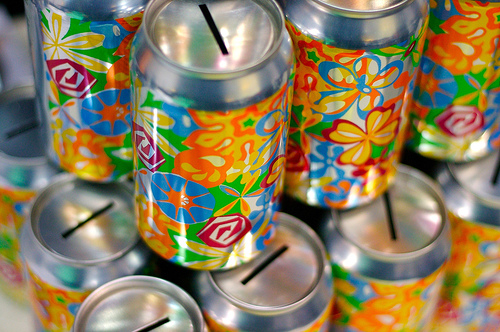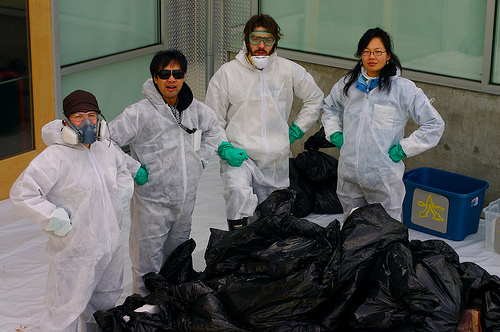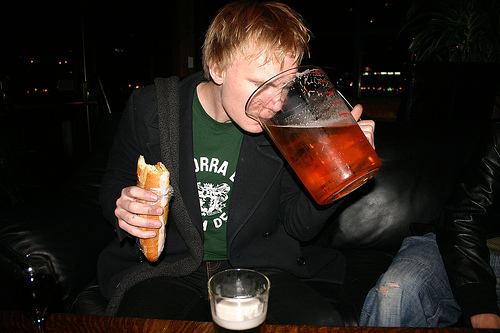A discussion with my class group was had at the Design Academy Eindhoven today on just what is (and what isn’t) cradle-to-cradle.
It was theorized that everything in nature is cradle-to-cradle; almost everything by man, is not. And some questions were raised, which I hope to answer both objectively and subjectively, as briefly and in as plain an English as possible:
- Is recycling different than cradle-to-cradle?
- Are beer bottles cradle-to-cradle?
- What other examples are cradle-to-cradle?

Are you cradle-to-cradle?
First I’ll define the concepts (as I understand them) so we all know what we mean when we talk about them:
Nature is sustainable. All of the following are man-made concepts and for our purposes we’ll only talk about them in relation to man-made things.
Sustainability is “a characteristic of a process or state that can be maintained at a certain level indefinitely.” Put another way: If a part of a thing (product, system) doesn’t last forever, it’s not sustainable.
Things are either more or less sustainable.
Cradle-to-cradle is a sub-category of sustainability.
Cradle-to-cradle is a framework (directions) used to design “production techniques that are not just efficient but are essentially waste free.”
Cradle-to-cradle comes in many levels that are more or less effective. Many designs can claim to be cradle-to-cradle, but some are better (less waste) than others.
There are many tools (techniques, technologies, strategies) we can use to design cradle-to-cradle.
Recycling is one tool of many than can be used in cradle-to-cradle.
Recycling is “the reprocessing of old materials into new products, with the aims of preventing the waste”
Reuse is different than recycling: you don’t make it into a new product or material. Composting is also different.

Maybe these are more sustainable? Donation caddies for the Recycling Council of British Columbia.
And so to answer the questions, I’ll apply the definitions above:
- Is recycling different than cradle-to-cradle? No.
Recycling is but one tool we can use in a cradle-to-cradle framework. - Are beer bottles cradle-to-cradle? Yes.
They are designed within a framework that strives for sustainability. The tool within that framework is ‘reusability’. Bottles are designed and manufactured to be strong. A deposit encourages people to return them. They are used again by beer producer. The cycle repeats. An imperfect system (beer bottles can break, they need cleaning), and the availability of better systems (maybe cans take less energy? maybe draft beer is less bad?), does not necessarily mean beer bottles are not cradle-to-cradle. - What other examples are cradle-to-cradle?
The Herman Miller Aeron chair. It is designed so all parts can be separated and then reused and/or recycled. Like beer bottles, it is less bad than many other chairs that were designed without thinking about cradle-to-cradle, but the Aeron is not as good as it could be.
Answering those questions makes me realize that I can look at many things and determine if they are cradle-to-cradle design by looking at not just the various stages they go through (production, use, reuse) but also the original design intentions and the other systems that are involved with them.

What parts are sustainable?
If someone asks me if this thing, or that thing, is cradle-to-cradle, I’ll turn around and ask of that thing: “What tools do you require to be efficient (less bad)?” And then I’ll ask each of those tools, “What tools do you require to be efficient (less bad)?” Or I can go from the outside in: “What is it about you that is sustainable? What is it about you that is cradle-to-cradle?”

Assessing sustainability
These thoughts are based on my own involvement and studies in sustainable design at the Emily Carr Institute in Vancouver, Canada, a 9-month internship in South East Asia with NGOs and businesses involved in sustainable design, and some quick Googlin’ tonight:
http://www.eciad.ca/studies/sustainable
http://www.mcdonough.com/cradle_to_cradle.htm
http://www.mbdc.com/cradle-to-cradle/
http://en.wikipedia.org/wiki/Sustainability

Visualizing the issues

Leave a Reply